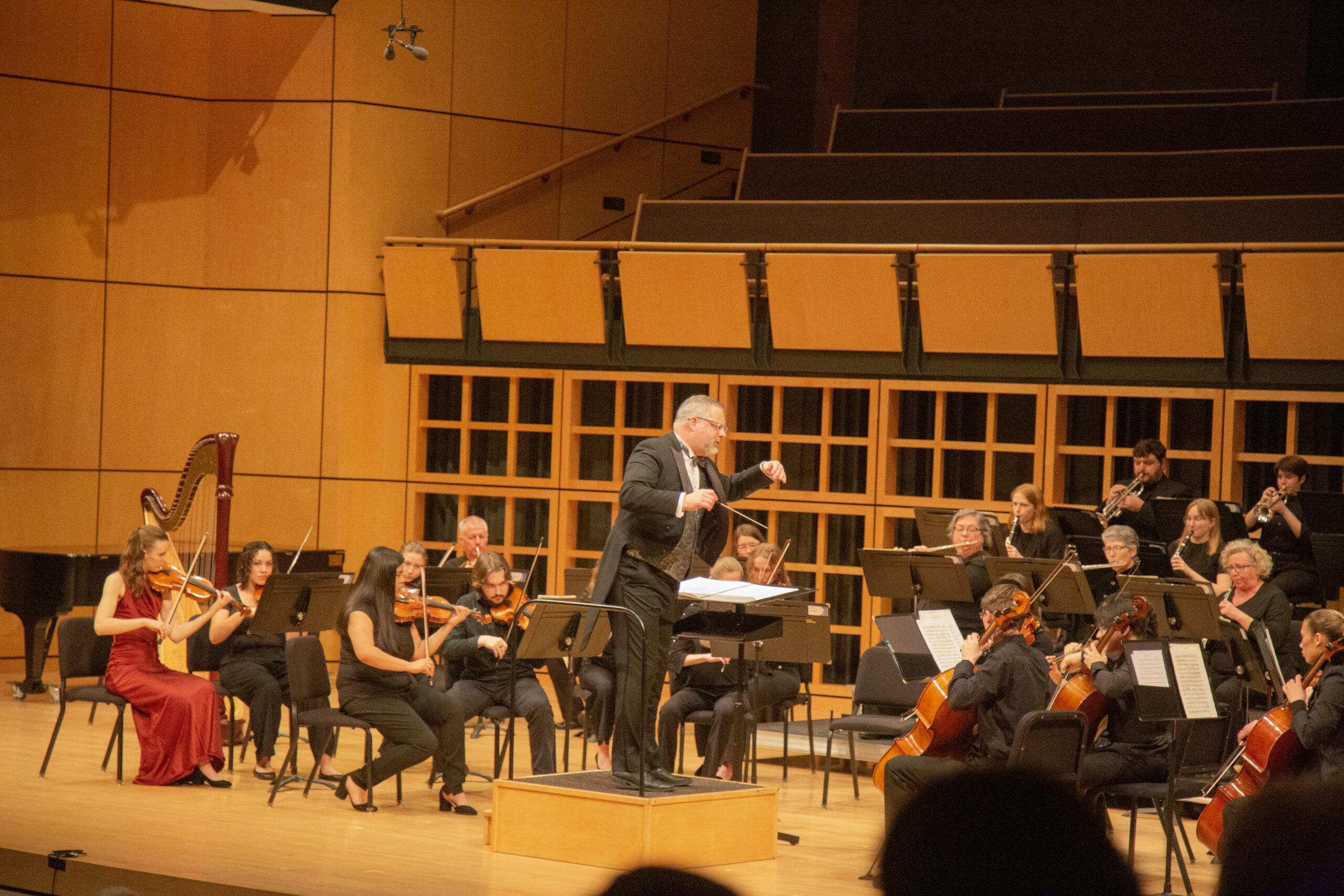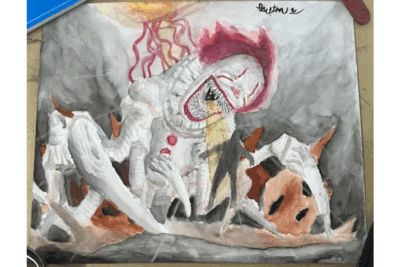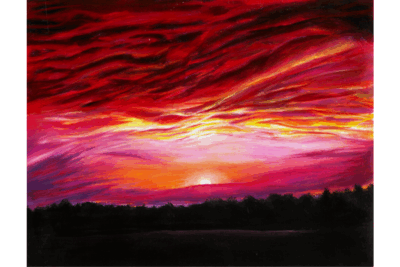A hush fell over the crowd in Sauder Concert Hall, which just minutes before had been raucous and boisterous. With the tuning of the Goshen College Symphony Orchestra fading away, the door on the right side of the stage opened.
As Brian Mast, the orchestra’s conductor, walked out to begin the 64th annual Concerto-Aria concert, the audience exploded with raucous applause.The orchestra began the night with a triumphant Mozart overture, the entrance to his opera “Die Zauberflöte” (The Magic Flute), giving the audience a feeling of brightness and excitement. The piece introduced the following one, “Wie, Wie, Wie?” from the same opera, which featured a quintet of soloists.
The quintet was made up of Dontaye Albert, Irish Cortez, Maggie Lapp, Victor Vegas and Fatima Zahara. They wowed the audience with their singing, and they also earned a hearty round of laughter thanks to Albert’s performance as Papageno, a tipsy bird-catcher. Their group was the first vocal quintet to ever perform at Concerto-Aria.
Soloist Madeline Bollinger followed the quintet with a heartfelt aria, “O mio babbino caro” by Giacomo Puccini. The aria was already a beautiful piece, but Bollinger’s ability to sustain her high notes while making the sadness in her voice crystal-clear made it one of the most touching moments of the evening.
Following Bollinger was Saige Lind, performing the first movement of Édouard Lalo’s “Symphonie Espagnole.” Lind had been practicing her eight-minute piece for roughly a year — evident through her musical flourishes during the performance, as she sang with her strings.
After Lind and a brief intermission, the orchestra performed a bold, frenzied piece from Mikhail Glinka before the next soloist took the stage.
Leif Billings, the next singer, performed a resonating version of Gaetano Donizetti’s “Quanto e Bella” from “L’elisir d’amore.” Billings said that the most important part of his performance was “to fully embrace the character” — a lover boy, made clear through his mournful yet sweet tone.
For the final performance of the evening, two grand pianos were wheeled out as the crowd once again grew quiet. Sasha Dyck and Julia Hyeyin Jun strode onto center stage, each to their respective benches facing each other over the pianos. There was a long pause; then, a wild piece began.
They performed “Concerto for Two Pianos and Orchestra in D minor” by Francis Poulenc. Dyck described it as “outrageous.”
It “feels like there are 50 different pieces within it,” she said. And while that might be an exaggeration, at times, it felt like the truth. The two of them had practiced together for nearly a year, and it was clear in their performance.
Dyck and Jun incorporated a mix of styles, from jazzy, groovy passages to cascading scales to haunting melodies. They traded the melody, at times letting the other play alone. As the piece ended, the audience rose from their seats for an ovation that seemed startlingly loud.
“I loved the cheering,” Mast said. “I felt like more of the campus community was at the concert than there typically has been [in the past].”
To say that the two weeks leading up to the concert were difficult for the orchestra would be an understatement; the performance came in the shadow of GC firing the previous conductor, Richard Brunson. Because of his departure, the orchestra only had three rehearsals with the soloists — and with Mast.
To compound matter, the night before the concert, the disgraced Brunson emailed all the students in the orchestra in a poor attempt to make them feel guilty. Billings described it as a “very strategically planned thing, like: ‘OK, if I’m not going to be involved with this performance, I’m going to [expletive] it up for all of you.’”
But in front of a raucous crowd Saturday night, the orchestra managed to put it all behind them and perform a moving concert full of life, joy and unity.
Billings, Dyck, Jun, Lind and Mast all echoed their praise for their fellow students. The four students also expressed gratitude toward Mast, who recently announced he would continue as director for the rest of the semester on top of his full-time job as the director of facilities.
Jun said that her mother was streaming the concert live from her home in Malaysia. She told Jun after the concert that their duet — two artists working together and with the orchestra, facing each other with pianos interlocking — was a perfect symbol of unity to end the concert on.
“We didn’t plan it,” Jun said, “but there was this underlying theme of unity in the concert, which spoke to all of us … despite all the separation and the breakage of things around us, it was a symbol of togetherness.”
This article and its headline was updated on March 14, 2024, to correct an error made by the writer. This was the 64th annual Concerto-Aria concert, not, as previously stated, the 63rd.




